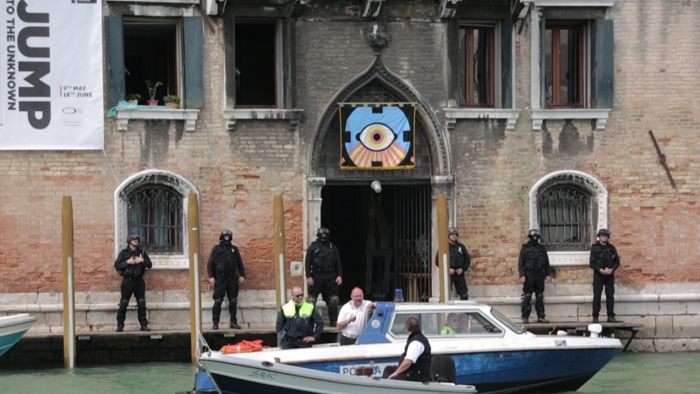‘If you’ve done nothing wrong you’ve got nothing to hide’ is an expression often used to in debates about surveillance. If one has no intention of breaking the law there is no need to fear being watched and to do so can itself create suspicion. This argument has obvious flaws, not least because some things should just remain private, but also because once universal and constant surveillance exists, the law can be manipulated to make new activities illegal, leaving little room for freedom of speech and movement. For these reasons, among many others, the rise of surveillance in the developed world has become an intensely debated topic over the last two years, and in particular since Edward Snowden’s revelations regarding US surveillance of civilians at home and abroad in conjunction with Australia, Canada New Zealand and the United Kingdom (an alliance collectively known as ‘Five Eyes’).
It was in response to this that I conceived the performance Machines of Loving Grace – an artistic collaboration with Dutch artist Harold de Bree – for the opening of the 56th Venice Biennale as part of the official collateral event Jump into the Unknown, organised by the South Korean foundation, Nine Dragon Heads. The performance, involving a modified Venetian boat, covered in armour, and six generic surveillance personnel (modelled on riot police), travelled across Venice during the opening days of the Biennale intimidating and entertaining the public in more or less equal measures. Harold and I travelled under the hood of the boat or nearby the performers on land, giving instuctions via CB radio. The intention of the performance, in mimicking the actions of the police by watching the public as a form of control, was to expose the emptiness of power as exercised by the State via a kind of shock conveyed by sudden unexpected actions, such as the routine formation of a human acrobatic triangle.

Machines of Loving Grace, Venice 2015. Photo: Antti Tenetz
When appropriate a publication made by Danish artist Magnus Clausen was circulated after the performance, entitled Black Flag. The booklet listed the rights of citizens upon arrest in all of the original 90 participating countries of the Venice Biennale. The title of the publication derives from the injunction which the office of the Biennale di Venezia issued to us during the process of gaining permission to feature the work as an official Biennale event. Our performers could fly a flag in any colour, so long as it wasn’t black, which was fine as we’d already designed one in red, yellow, white and blue, based on the original flag of the USA, depicting the ‘all seeing eye’ which often features on masonic and military insignia. The flag will hang outside Jump into the Unknown at Palazzo Loredan, on the Grand Canal, for the duration of the exhibition.
The effectiveness of the action was in part reflected in the amount of times we were stopped by the Venetian police, creating a surreal effect as reality clashed with fiction. On the last day of performances we were held outside Palazzo Loredan dell’Ambasciatore for 30 minutes whilst ID documents and Biennale permissions were checked. Following this, and running late, we passed by the occupation of the Peggy Guggenheim Foundation by Gulf Labour, GULF (Gulf Ultra Luxury Faction), SaLE Docks and MACAO and saluted their opposition to poor working conditions in Saadiyat Island, where construction workers at Guggenheim Abu Dhabi and Louvre Abu Dhabi have suffered slave-like working conditions.

Protest outside Peggy Guggenheim Foundation, Venice Biennale, May 2015. Photo: Mike Watson
Around 40 occupiers held up a banner bearing the slogan ‘Meet Workers Demands’ which was also intended in solidarity with often underpaid Biennale workers. Niccolò Bocenti, our boat driver and a well known activist slowed the boat down as we passed causing confusion and fear among both activists and police before it was made clear amongst the former that we were there in support of them. Later, in the Giardini, a plain clothes police officer requested that we make our movements known to him as the Venetian police were being inundated with emergency calls from worried members of the public who presumably feared we were violent extremists. Though reactions were mixed, many people interacted with us in good humour, stopping for photo opportunities. Indeed, what the performance confirmed was that surveillance and fear of it, is in part a psychological issue. As surveillance increases the most disarming thing we can do is ignore it.
Watch a video clip of Machines of Loving Grace
Read all 39 of our 2015 Venice Questionnaires
Online exclusive published 14 May 2015
